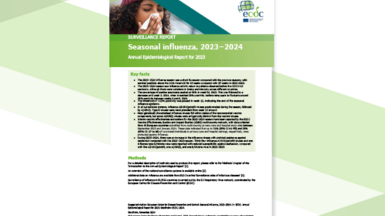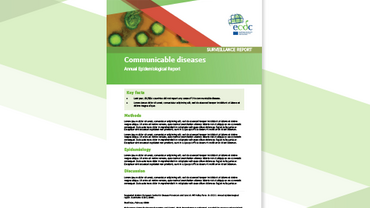Influenza virus characterisation: Summary Europe December 2012
During the 2012–13 season, A(H1N1)pdm09, A(H3N2) and B/Victoria and B/Yamagata lineage influenza viruses, with collection dates since 1 September 2012, have been detected in relatively low numbers in ECDC-affiliated countries. However, the situation varies from country to country:• Type A and type B viruses are co-circulating in approximately equal proportions.• A(H3N2) and A(H1N1)pdm09 viruses have been detected at comparable levels, with a recent rise in the proportion of A(H1N1)pdm09 viruses.• A(H1N1)pdm09 viruses continued to show genetic drift from the vaccine virus, A/California/07/2009, but the vast majority remained antigenically similar to it.• The vast majority of A(H3N2) viruses have been antigenically similar to A/Victoria/361/2011, the vaccine virus for the 2012–13 influenza season.• B/Victoria lineage viruses fell within, and were antigenically similar to, reference cell-propagated viruses of the B/Brisbane/60/2008 genetic clade.• Recent B/Yamagata-lineage viruses fell into two genetic clades: clade 2 represented by B/Estonia/55669/2012, and clade 3 represented by B/Wisconsin/1/2010 (the vaccine component for the 2012–13 influenza season). Clade 2 viruses have predominated over clade 3.
Executive Summary
The latest issue of ECDC’s monthly series on 'Influenza virus characterisation’ covers the time period from September to December 2012. It is a follow-up of the previous month's report.
Since 1 September 2012, A(H1N1)pdm09, A(H3N2) and B/Victoria and B/Yamagata lineage influenza viruses have been detected in relatively low numbers in ECDC-affiliated countries. The report summarises the findings as follows:
Type A and type B viruses are co-circulating in approximately equal proportions.
A(H3N2) and A(H1N1)pdm09 viruses have been detected at comparable levels, with a recent rise in the proportion of A(H1N1)pdm09 viruses.
A(H1N1)pdm09 viruses continued to show genetic drift from the vaccine virus, A/California/07/2009, but the vast majority remained antigenically similar to it.
The vast majority of A(H3N2) viruses have been antigenically similar to A/Victoria/361/2011, the vaccine virus for the 2012–13 influenza season.
B/Victoria lineage viruses fell within, and were antigenically similar to, reference cell-propagated viruses of the B/Brisbane/60/2008 genetic clade.
Recent B/Yamagata-lineage viruses fell into two genetic clades: clade 2 represented by B/Estonia/55669/2012, and clade 3 represented by B/Wisconsin/1/2010 (the vaccine component for the 2012–13 influenza season). Clade 2 viruses have predominated over clade 3.
The next influenza virus characterisation report will be published in March 2013 and will cover data on the 2012-2013 influenza season from September 2012 to February 2013.






